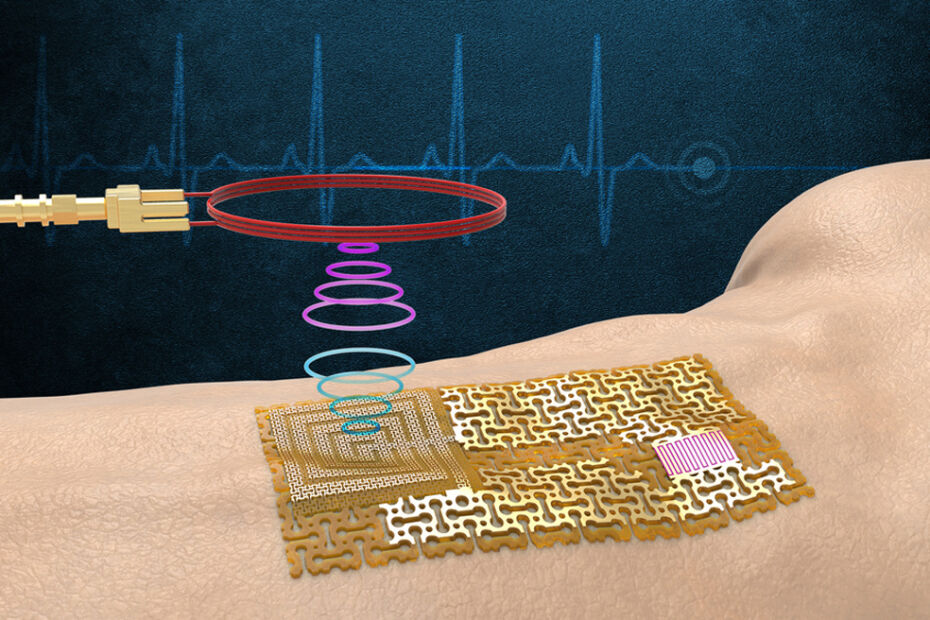Electronic skin wirelessly transmits medical data
- September 12, 2022
- Steve Rogerson

Engineers from the Massachusetts Institute of Technology (MIT) have developed an electronic skin that senses and wirelessly transmits signals related to pulse, sweat and ultraviolet exposure, without bulky chips or batteries.
Wearable sensors are ubiquitous thanks to wireless technology that enables a person’s glucose concentrations, blood pressure, heart rate and activity levels to be transmitted seamlessly from sensor to smartphone for further analysis.
Most wireless sensors communicate via embedded Bluetooth chips that are themselves powered by small batteries. But these conventional chips and power sources will likely be too bulky for future sensors, which are taking on smaller, thinner, more flexible forms.
Now MIT engineers have devised a kind of wearable sensor that communicates wirelessly without requiring onboard chips or batteries. Their design, detailed in the journal Science, opens a path towards chip-free wireless sensors.
The team’s sensor design is a form of electronic skin, or e-skin, a flexible, semiconducting film that conforms to the skin like electronic Scotch tape. The heart of the sensor is a thin, high-quality film of gallium nitride (GaN), a material known for its piezoelectric properties, meaning it can both produce an electrical signal in response to mechanical strain and mechanically vibrate in response to an electrical impulse.
The researchers found they could harness GaN’s two-way piezoelectric properties and use the material simultaneously for sensing and wireless communications.
The team produced pure, single-crystalline samples of GaN, which they paired with a conducting layer of gold to boost any incoming or outgoing electrical signal. They showed the device was sensitive enough to vibrate in response to a person’s heartbeat, as well as the salt in their sweat, and that the material’s vibrations generated an electrical signal that could be read by a nearby receiver. In this way, the device was able to transmit sensing information wirelessly, without the need for a chip or battery.
“Chips require a lot of power, but our device could make a system very light without having any chips that are power-hungry,” said the study’s corresponding author Jeehwan Kim, an associate professor of mechanical engineering. “You could put it on your body like a bandage, and paired with a wireless reader on your cell phone, you could wirelessly monitor your pulse, sweat and other biological signals.”
Kim’s co-authors include first author and former MIT postdoc Yeongin Kim, who is now an assistant professor at the University of Cincinnati; co-corresponding author Jiyeon Han of the Korean cosmetics company AmorePacific, which supported the current work; members of the Kim Research Group at MIT; and other collaborators at the University of Virginia, Washington University in St Louis, and multiple institutions across South Korea.
Jeehwan Kim’s group previously developed a technique, called remote epitaxy, that they have employed to grow quickly and then peel away thin, high-quality semiconductors from wafers coated with graphene. Using this technique, they have fabricated and explored various flexible, multifunctional electronic films.
In their new study, the engineers used the same technique to peel away thin single-crystalline films of GaN, which in its pure, defect-free form is a highly sensitive piezoelectric material.
The team looked to use a pure film of GaN as both a sensor and a wireless communicator of surface acoustic waves, which are essentially vibrations across the films. The patterns of these waves can indicate a person’s heart rate or, even more subtly, the presence of certain compounds on the skin, such as salt in sweat.
The researchers hypothesised that a GaN-based sensor adhered to the skin would have its own inherent, resonant vibration or frequency that the piezoelectric material would simultaneously convert into an electrical signal, the frequency of which a wireless receiver could register. Any change to the skin’s conditions, such as from an accelerated heart rate, would affect the sensor’s mechanical vibrations, and the electrical signal that it automatically transmits to the receiver.
“If there is any change in the pulse, or chemicals in sweat, or even ultraviolet exposure to skin, all of this activity can change the pattern of surface acoustic waves on the GaN film,” said Yeongin Kim. “And the sensitivity of our film is so high that it can detect these changes.”
To test their idea, the researchers produced a thin film of pure, high-quality GaN and paired it with a layer of gold to boost the electrical signal. They deposited the gold in the pattern of repeating dumbbells, a lattice-like configuration that imparted some flexibility to the normally rigid metal. The GaN and gold, which they consider to be a sample of electronic skin, measures just 250nm thick, about 100 times thinner than the width of a human hair.
They placed the new e-skin on volunteers’ wrists and necks, and used a simple antenna, held nearby, to register the device’s frequency wirelessly without physically contacting the sensor itself. The device was able to sense and wirelessly transmit changes in the surface acoustic waves of the GaN on volunteers’ skin related to their heart rate.
The team also paired the device with a thin ion-sensing membrane, a material that selectively attracts a target ion and, in this case, sodium. With this enhancement, the device could sense and wireless transmit changing sodium levels as a volunteer held onto a heat pad and began to sweat.
The researchers see their results as a first step towards chip-free wireless sensors, and they envision the current device could be paired with selective membranes to monitor other vital biomarkers.
“We showed sodium sensing, but if you change the sensing membrane, you could detect any target biomarker, such as glucose, or cortisol related to stress levels,” said co-author and MIT postdoc Jun Min Suh. “It’s quite a versatile platform.”




